« It's been much too long | Main | Bad air »
July 16, 2012
Exploring the Sea of Cortez onboard the Rocio Del Mar
From July 7 to 14, 2012, we were onboard the live-aboard vessel Rocio Del Mar for a week of diving the Midriff islands of the Sea of Cortez, also known as the Gulf of California. These islands are about 40% down the gulf to the southern tip of Baja California. The Rocio is a rather new ship, only a few years old, 110 feet long, and especially built for dive trips.
We arrived in Phoenix via USAir to sweltering heat, called the shuttle company that was going to bring us to the Mexican port town of Puerto Penasco (Rocky Point), grabbed a sandwich at Starbucks, and then boarded the shuttle, a spacious air-conditioned 10 passenger van. The ride from Phoenix to Rocky Point is about 2/3 in the US and 1/3 in Mexico. It is actually a rather scenic drive through desertlike terrain with millions of cacti. There are several border patrol checkpoints on the US side of the border, but with only cars headed for Phoenix being checked. We stopped at a refueling plaza for a Subway sandwich.
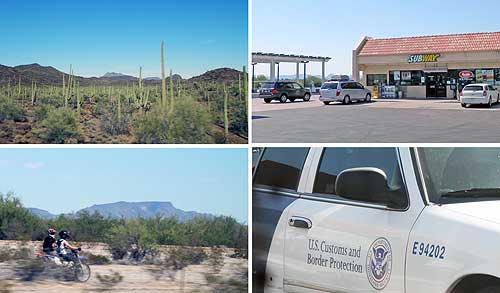
Passing the border into Mexico was a non-event. We didn't even have to show our passports. The ride to Rocky Point took about four hours all in all, and we arrived about 5:30pm. There is great access to the port area where we saw the Rocio Del Mar right away.
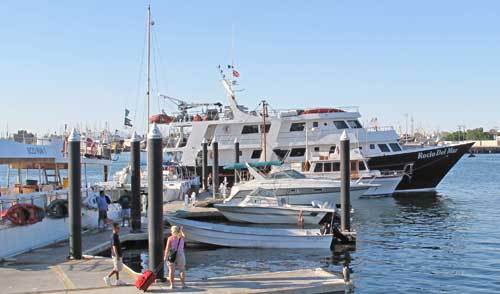
It's an impressive ship and leaves a good first impression. Whereas the Solmar V is sleek and has a pub-like elegance, the Rocio Del Mar looks and feels almost more like a building than a ship. Boarding is always a hectic affair, what with figuring out what is where, and then getting the dive gear set up. On most live-aboard and dive boats I have been on, there is bench seating where divers can prep and don their gear. The Rocio, on the other hand, has stand-up dive stations. That struck me as unusual at first, but I’d quickly learn that getting into your gear from a standing position is actually a lot easier.
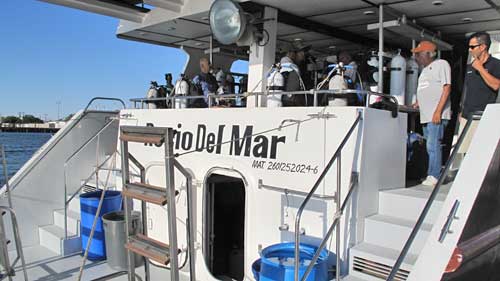
The rooms are, for live-aboard standards, very large. Our upper deck room had a double bed, a bunch bed on top of it (with very ample headroom), a chest of drawers, large windows, and superb air conditioning (that can, however, only be regulated via adjusting the vents). It measured perhaps 8 x 8 feet and at least seven feet high. Our bathroom had a decent shower, a nice sink, a window, a mirror, and a toilet. The were dispensers for soap and shampoo. As on many boats, you're supposed to put toilet paper in a waste paper basket next to the toilet, and not into the toilet itself. That sounds a bit gross, but works much better than I expected.
The mattresses were on the thin side, sort of like sofa cushions, but not uncomfortable. According to management, they will be replaced with thicker memory foam mattresses. We had two foam pillows for our double bed. We also found more than adequate power outlets. That's always a big plus if you bring along a lot of cameras and electronics.
The dining room was downstairs in the hull; a relatively compact room with three large tables and bench seating that tended to get loud during meals.
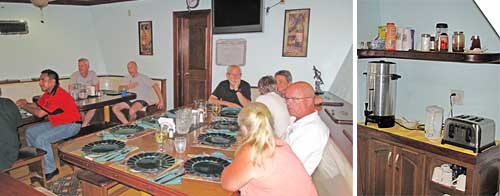
The top deck of the Rocio provided an absolutely panoramic view. The was no roof to provide shade, but the feeling to be on top of everything, in the middle of the ocean, was amazing. We found lounging chairs, a barbecue grill, one of the two inflatables, a crane, and all sorts of gear, without it being cluttered.
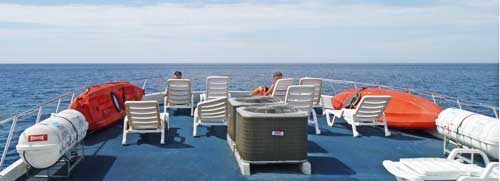
After our first dinner, one of the dive masters, Mayo, did a briefing on the ship, safety measures, schedules, and he also introduced the crew. He first explained everything in Spanish and English, but it turned out that the Hispanic guests spoke and understand English much better than the Anglos understood Spanish, and so it was mostly English the whole trip.
Given that the two ships mostly do the same itineraries, it is interesting how different the Rocio Del Mar is from the Solmar V. If the Solmar had a nationality, it'd be British, with all of its stained glass and mahogany and brass. The Rocio is all Mexican; comfy and colorful and with much larger rooms. Some of the corridors and passages were narrow, as were some of the stairs, but that’s the case on most ships. The decor used a good deal of wood.
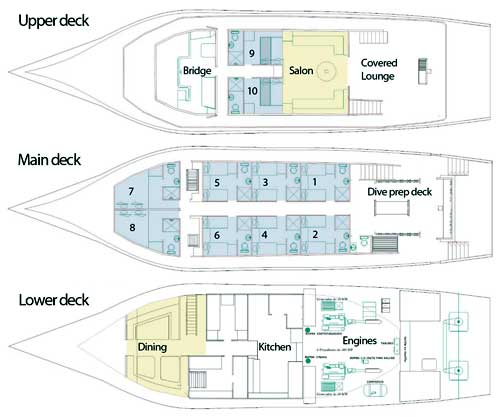
The guests, by and large, were an older crowd, and almost all very experienced world-traveling divers. Among them were a free diver with her son, a travel videographer, a couple who owns a dive shop in upstate New York, two retired university professors, a French woman with a Ph.D. in Astronomy who now teaches math on the French island of Reunion in the Indian Ocean, three Mexicans into photography, a mathematician, a Microsoft techie, etc. Most had many hundreds to several thousands of dives. My 250 ranked third or fourth from the bottom.
Sunday, July 8....
I woke up around 6:30am after a rather restful night where I only occasionally became aware of the motion of the boat. I went outside and found that we were not moving, and no land was in sight. I took the opportunity to do some photography, and then had breakfast where our hostess and co-owner of the Rocio Del Mar, Dora, informed us that at 3:00am there had been some rather intense vibration underneath the boat. Initially they suspected that one of the props had gotten entangled in a fishing net. That didn't turn out to be the case. Instead, one oft the drive shafts had gotten out of balance and then broke. The prop wasn’t lost and there was no danger, but the boat's top speed was now seven knots instead of ten, and the shaft could not be fixed other than in dry dock.
Our options were to return to Puerto Penasco, or to continue on one propeller, have a modified itinerary, and then conclude the trip somewhere on Baja, from where we'd be transported back to Phoenix via bus, a seven hour trip or so. Since everyone was already here and the trip underway, it made more sense to continue and then put the boat on dry dock for the necessary repairs.
So we went on at a leisurely pace that gave us ample opportunity to relax, organize, familiarize ourselves with the layout of the Rocio, and for us also do some of the product photography there usually never seems enough time for.
At 11am was a briefing on the dive operations in the salon where we learned about the general diving conditions in the Sea of Cortez. Tides can make a large difference here in current, water temperature, and visibility. Temperatures can be as low as the high 60s, then be in the low 80s on the next dive. There can also be large thermoclines. All the diving on this itinerary would be off the two inflatables. There would be no drift diving, and everyone must stay with the group as drifting off and doing safety stops in current can get you far away. Diver put on their gear before entering the inflatable and enter the water via back roll. For every dive there is a record sheet where everyone lists starting and ending pressure, and Nitrox users also their percentage and MOD. Depth limit for air users was 130 feet.
Each diver would be issued a walkie talkie GPS device that clips onto the BC. It has a green button for talk with the inflatable captains, an orange one for talk with any other boat in the area, and a coved red one to reach the coast guard in case of true emergency. The devices have a coordinate readout that is broadcast in emergencies. The LCD readout is quite small and I could not read it without my reading glasses. It struck me as a design that could use some improvements.
Due to the slower pace, we had a chance to talk with Dora Sandoval about the boat. She and her husband, who is the captain of the Rocio, did start from scratch, building the boat practically themselves, with the help of a small crew of workmen. They started in 2006, did the first trips in 2008, and Dora related a number of interesting stories and anecdotes about the whole process. I mean, how many people built a live-aboard from scratch?
At long last we arrived at Angel Island about five o'clock on Sunday. The vistas there are just breathtaking, with different color rock in dramatic shapes, spires and cones peeking out of the water, interesting beach and tide pool areas where you can see the impact of the tides in the Sea of Cortez, and no signs of civilization at all. Beautiful.
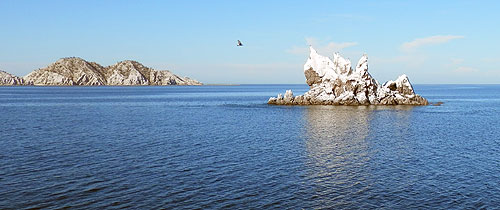
The first dive site was La Muela, a craggly spire poking out of the water near the Island. It actually looked a bit like a smaller version of Roca Partida in the Socorro Islands. Divers were split into two groups for the inflatable rides. We geared up and realized the advantage of having the tanks and BCs parked higher up, so that we could just walk up to the gear and put it on, without then having to get up from a sitting position. Getting onto the inflatable with all the gear on was surprisingly easy. The ride to the site was just a couple of minutes, and then we were off to our first dive, entering backwards.
The water wasn't particularly clear, but fairly warm. We tested buoyancy, waited until everyone was in the water, then descended and made for the base of the rock. There wasn't any current, but we couldn't really see enough to stay together as a group. What was unique here was the billions of krill in the water that made it just like swimming through a living soup. This was primarily a macro site and dive master Mayo pointed out a number of interesting critters, including seahorses and numerous nudibranchs. I also saw a small ray. There was quite a bit of life, but the krill made things hard to see. It still became a 63 minute dive with a max depth of 60 feet.
We emerged almost right next to the inflatable, took off fins, then weight pockets, then handed up the BC. The ride back to the Rocio was picturesque, and the subsequent easy stroll between Angel Island's coast and rocks in the dusk almost achingly beautiful. Just gorgeous and almost worth the trip alone.

A few hardy souls made the night dive. The boat was surrounded by thousands of needle fish that at times jumped out of the water and even on the dive deck. Carol and I went on the front deck to watch the stars for a while. It's just amazing how well you can see the Milky Way when there is no light from civilization.
Monday, July 9...
The next morning we woke up to a spectacular view through our cabin window. There was the triangular La Vela ("The Sail") formation, a sugar cone like rock perhaps 100 feet tall. There are thousands of birds on it and it is white from guano. That doesn't sound very appetizing, but it looks dazzling and very attractive. At the bottom sat dozens of sea lions.
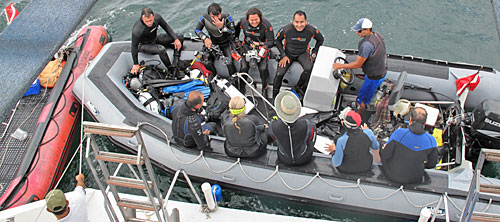
It was just a very short inflatable drive close to the rock. We went in backwards again, then dropped almost to the bottom of the rock, which slopes down underwater at perhaps a 45 degree angle in a series of walls. The visibility wasn't great, but cleared up as we got deeper. At 90 feet it was quite good if you stayed close to the rock. I shot video using my home-made GoPro rig with its pistol grip and two Liquid Image lights. It worked great.
We saw hundreds of Spanish Shawls and other nudibranchs and also a few small rays. As we got higher, the sea lions began buzzing us, showing off and doing their thing. It wasn't clear enough to really see them play, they just came and went. Nice dive overall, and certainly a very picturesque setting. There was lush vegetation and it was sort of a mix between what you see in the Pacific (urchins, sea stars, nudibranchs, kelpish plants) and in the Caribbean (sea fans, sponges, angel and damsel fish, etc.).
After breakfast we got ready for the second morning dive, this one again at the La Vela site. The sun was out, it was hot, the water almost flat, and the sea lions were barking up a storm. This time the inflatable took us behind the rock so that we had a better chance to go with the current, or stay out of it. For photography I took my trusty Canon G10 and Carol had the GoPro 3D setup with its two big Bonica lights. I initially had a problem going down due to sinus pains. After acclimating a bit and staying above the group, things cleared up and I could descend.
Visibility was passable this time and the group stayed close to dive master Mayo. There was lots to see, mostly on the macro side, but also many rays. We heard sea lions barking throughout the dive, but didn't see them until we had ascended from 80 to perhaps 30 feet or so. Seems like the sea lions like the shallower waters. After that, a good number darted in and out.
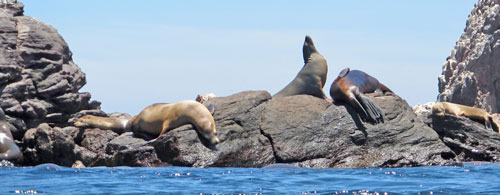
This dive lasted an hour. After the inflatable picked us all up, we circled around the La Vela rock and watched a big make sea lion asserting his authority, barking at pups, reining in females who had climbed up too high on the rocks (they are amazingly adept at climbing rock!), and chasing one away. Back at the Rocio Del Mar, a big pelican leisurely sat on one of the pangas and couldn't be shooed away.
After lunch, the inflatable took those who wanted to explore the island over to the beach. There are not many places as pristine as this that you can set foot on.
The first afternoon dive was still at Angel Island at a site named LoLo's Cove. It's in front of a rocky cliff that then drops down to 70 feet and more, but also has an attractive shallow reef with large boulders, tunnel swim-throughs, lots of vegetation, and veritable storms of krill, so much that you can hardly see through it. I again had a hard time going down due to sinus pain above my right eye. It took almost ten minutes to go below 20 feet. Then it was okay. Unfortunately, the first half hour of what would be a very nice dive was in near pea soup. A shallow reef towards the end was more pleasant, with more sun and a bit more visibility.
After the dive, the Rocio’s crew served fruit and chicken wings in the upstairs lounge. We had already come to greatly appreciated the unique layout of the Rocio Del Mar where divers can lounge either outside in a comfy porch/terrace style settings or inside where it is cool and there's a fridge always filled with soft drinks, water and beer.
For another treat, photographer Javier Sandoval organized a boat ride for his students to a sea lion colony and some sunset shooting. Those who went spoke of a wonderful experience.
As far as water temperature went, the first four dives mid June at Angel Island saw from 74 to 78 degrees Fahrenheit at the bottom. We had drastic thermoclines and temperature changes where one spot felt warm like bath water, the next downright chilly. Air temperatures were quite high, in the 90s, and putting on a wetsuit instantly made you work up a good sweat in the heat and humidity. But in the water I was glad I brought my 5-mil wetsuit.
Tuesday, July 10....
This was whale shark day! During the night, the Rocio had moved to a new location in Bahia de los Angeles, a large cove at Baja California. When we woke up, it looked like we were totally surrounded by land, but that was an optical illusion. After breakfast we left the Rocio in snorkel gear on one of our inflatables and a panga run by a local operator who specializes on whale sharks. It was a cloudy, which cut down on the heat, and the water was absolutely flat. We searched for whale sharks for perhaps 15 minutes, then found four or five, including a young one.
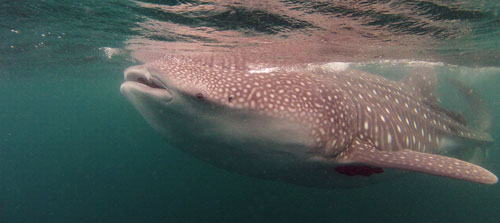
Most of us wore a wetsuit or skin and were ready to jump in whenever a whale shark was near. It was an incredible experience to be face to face with whale sharks, and being able to swim with them for minutes at a time. The boat operators adeptly put us in good positions and told us where to go. We had several cameras in the water and and also shot 3D video. The water was warm and calm enough to just hang and wait for either the boat to pick us up or for a whale shark to arrive. We did not want to leave after the allotted three hours were up and convinced the captains to let us go back into the water a few extra times.
No sooner did we get in dry clothes back on the Rocio than a veritable stampede of hundreds of small bottlenose dolphins swam alongside and in front of the Rocio, jumping and pouncing and playing. What a stunning sight!
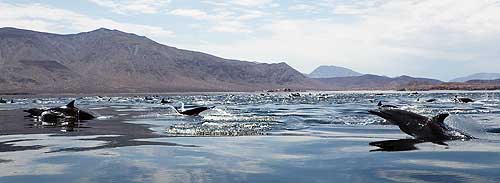
The afternoon dive was at a bay along Baja at a dive site named El Pescador, one of Dora's favorites. The water looked a bit green, but there was enough sun to light up the very nice reef top and then broad sand chutes with little rays, goofy puffers and then impressive rock formations and valleys full of life. It got quite dark at around 70 feet and the current was strong around some of the cliffs, but this was a very nice dive. Again, I was surprised at the mix between Caribbean and Pacific features. The water was about 77 degrees.
Later in the afternoon we saw a number of large pilot whales and some one of the inflatables went out to see them up close (they disappeared). We were also on the lookout for the sperm whales that often make an appearance in this part of the Sea of Cortez, but saw none. We again skipped the night dive; for me there just isn't that much appeal diving a place I don't know where it is murky to boot.
Wednesday, July 11...
The next morning we woke up as the Rocio Del Mar arrived at the small island of Salsipuedes. The name, I am told, translates into "leave if you can!†and Salsipuedes is indeed a low, barren place nowhere near as attractive as Angel Island and the others we had seen.
Our first before-breakfast dive was at a site called Los Cuervos near a virtually submerged pinnacle that peeks out of the water by a mere foot or so. There's a second, larger one close-by, and the idea is to seek places where there is little or none of the current that usually whips around such peaks in the water. We all dropped off the inflatable together so that if there was drift, the usual two groups would not drift apart. We descended into what turned out to be rather murky water with visibility of no more than five or ten feet. Once we reached the pinnacle we dropped down alongside it to about 90 feet where it was almost totally dark. My GoPro setup's two video lights sure came in handy.
The scenery down there was surprisingly lush, again with that unique mix of Caribbean and Pacific features. We slowly worked our way up the rock which turned out to have numerous cuts and walls and little canyons to swim to, around, through and into. As we got higher, we encountered schools of large and colorful angel fish. With good light and visibility, this would be a terrific dive site. The temperature at Salsipuedes was a decent 77 degrees, just about right for the 5mils.
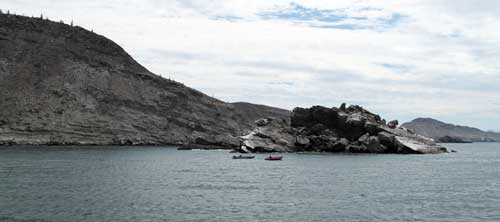
The surface intervals on the Rocio were always long, long enough to take your wetsuit off and relax. That's because of their unique schedule of having continental breakfast items at 6am, then the first dive at 7:30, then real breakfast, then the second morning dive at 11:00 or so, lunch at noon, the first afternoon dive at 2:30, the second at 5:30pm or so.
Not being much of a fan of murky water, I sat out the second morning dive to another emerged pinnacle dive site named El Caballo, still part of the Salsipuedes island. Carol said the viz was not good, there was much current and choppiness, but she greatly enjoyed the dive nonetheless.
After lunch we were treated to a fascinating lecture on free-diving by Marie Terese Solomons, a free diving instructor in La Paz.
Afternoon dive was a dive site called "El Lavadero," still at Salsipuedes. This one was again near a rock face, but offered shallow diving, which came in handy because we needed to test the waterproof cameras on real dives. Also along came 14-year-old Zef, MT's son. Mayo was teaching him adventures in diving and so he got to enjoy his fourth ever scuba dive in a challenging site off an island in the Sea of Cortez. Quite a bit more dramatic than my fourth dive in Folsom Lake.
Thursday, July 12.....
During the night the Rocio had moved to the tiny, but rather impressive guano island of San Pedro Martir. The weather was nice, the sea fairly flat with a bit of wind, and there were hundreds of those goofy booby birds with their duck feet. They sat on the boat, bopped each other off, and clumsily flew around the Rocio again and again. On the rock face of the island, which is still mostly guano despite a history of mining it for fertilizer, you can still see terraces of stone used by the guano miners.
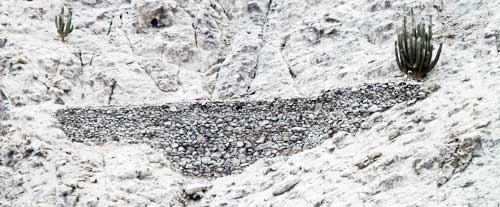
Diving bright and early at the El Arroyo site, it was immediately clear that we had warmer water and much better visibility here. The site was close to the island and we could almost see the bottom from the boat. We descended first to a shallow area, then moved down towards and over a wall. The drop was fantastic, vertical, full of life and colors, and seemed to drop into the abyss. We went down to 80, 90, 100, 110 and I leveled off at 114 since I used Nitrox. Some of the air divers went down to what looked like well past the 130s and stayed well below us for a while. All of a sudden one guy shot upward, with the dive master in pursuit, finally stopping him. Apparently, the guy has experienced some narcosis and kept pushing the inflator button instead of dropping air as he came up.
We saw a moray, the first on this trip, and some cute blennies emerging from their holes in the sand. We also saw Marie Terese free diving to impressive depths, and a large male sea lion defending his turf. The water was a nice 82 degrees and I wished all dives were like that.
The second dive was again at El Arroyo, but closer to the sea lion colony. The water was not quite as clear as in the morning and we stayed on a rocky slope at 30 to 50 feet, which made the site suitable for testing some of our waterproof cameras. Dive master Mayo encircled an area with his line, indicating to look there for sea horses. We did, but found none. Instead we got many visits from sea lions, generally one at a time, doing underwater acrobatics. Towards the end of the dive we encountered a large male sea lion who elegantly cruised by like a submarine, blowing bubbles and draw a line we must not cross. We didn't.
Lunch was a very tasty chicken soup with hominy (which I loved and Carol hated), and Tostitas with beef. I would have loved to go back diving one more time at San Pedro Martis, but the ship then went looking for sperm whales. Several hours looking for them proved futile and so the Rocio Del Mar returned to San Pedro Martir for a dusk dive.
That one, Ravijunco, started at 6:30, close to a rock and a sea lion colony and quickly became a dusk dive. Carol and I both had dual lights and GoPros. A big male sea lion cruised by somewhat menacingly, and dive master Mayo decided to move on. We wound our way through a reef-like seascape, encountering substantial surge. There were the dense clouds of krill, schools of small fish, moray eels in their holes, and a good number of octopus. By the end of the one hour dive it was nearly dark, so I got to do a night dive after all.
For dinner, the crew had fired up the grill on the top deck, ran mariachi music, and so we ate excellent Beef Fajitas in the warm breeze.
Friday, July 13...
We woke up to choppy seas and an overcast sky off San Pedro Martir. Got started with coffee, changed batteries in cameras, and got ready for the 7:30 dive. A small Mexican fisher boat with some half dozen fishermen came by and asked if they could have some water and tortillas. The boat gave them what they needed. Must be a hard existence to be out here for some marginal fish and absolutely no amenities. Apparently fishing is still allowed in this part of the Sea of Cortez.
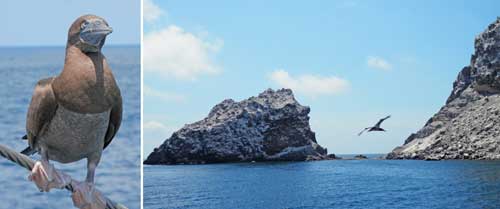
The dive site was called Chayo's Cove, named after a tall, impressive cavern in the rock at about 30 feet. Inside the cavern was a cave like extension that then exited back into the cavern at another point. Marie Terese used her mermaid monofin this time and we got some good footage of her free-diving with it. She even went into the cavern and through the cave passages. Sea Lions came down and swam around us and also in and through the cave. One time, as I went around a bend, a sea lion came in from the other direction, startling bot of us. He stopped cold in his tracks, turned around and dashed off. On a second dive at Chayo's Cove, we gradually dropped to almost 110 feet along an interesting slope with lots of rock, sea fans, and little critters. Seals came and visited even at depth, as did free-diver MT at 85 feet. On the way down and then up we encountered a massive 10 degree thermocline with shimmering water separating the layers. At the bottom it was 76 or 77, on top as much as 86.
I skipped the final afternoon dive and instead collected my dive gear and laid it out on the top deck to dry (wouldn't want to get docked by the airlines for being 1.5 pounds overweight!). Time flew and soon it was time for the final dinner of the trip, and then settling our accounts with Dora. After that, some of the photographers onboard showed the week's best shots in the lounge. They did some incredible work. Then we packed, set the alarm to 4am, and were out like lights.
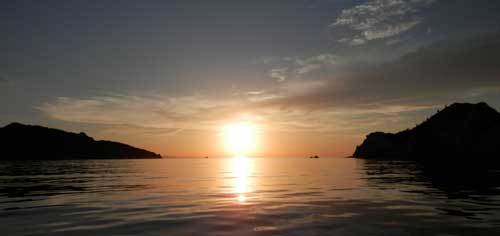
Saturday, July 14...
The knocks on the door coincided with the iPhone's wake-up tune. Getting up at 4am was brutal, with the sky still dark. Somehow we made it to the dining room, had some coffee and a bit of breakfast, then took one last pass through our belongings to see if everything was accounted for. We were quite a ways from shore, and so the luggage went on one inflatable, us folks on another. The pier at Kino was tall and so we had to grab an iron ladder to get off the inflatable in a bit of rough water. We made it. Then we separated into different groups, some going back to Puerto Penasco, some to Phoenix, and some to some other place. The van service was waiting, we took one last look at the Rocio Del Mar floating far in the distance on the water, said our goodbyes, then boarded the vehicles and settled for a long seven hour ride through the Mexican countryside back into the US and Phoenix.
It was a nice ride with interesting sights, a couple of checkpoints, including one in a storm where we had to take all the bags out of the trailer and through an x-ray machine. Along the way we encountered some rather impatient Mexican drivers, colorfully decorated shops and businesses, numerous of those deadly speed bumps Latin American nations love to put on their roads, and finally the US border where re-entry was no big deal.
Time had flown by and we couldn’t believe our wondrous adventure onboard the Rocio Del Mar was over. We’re ready to go back!
Posted by conradb212 at July 16, 2012 1:34 AM








